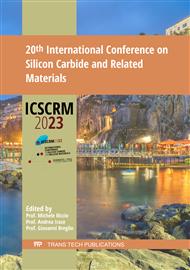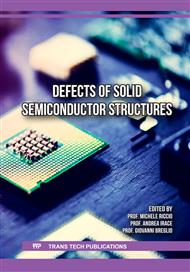[1]
I. Kamata, X. Zhang, H. Tsuchida, Photoluminescence of Frank-type defects on the basal plane in 4H-SiC epilayers, Appl.Phys. Lett. 97 (2010) 172107.
DOI: 10.1063/1.3499431
Google Scholar
[2]
T. Yamashita, H. Matsuhata, Y. Miyasaka, M. Odawara, K. Momose, T. Sato, M. Kitabatake, Characterization of (4,4)- and (5,3)-type stacking faults in 4deg.-off 4H-SiC epitaxial wafers by synchrotron X-ray topography and by photo-luminescence spectroscopy, Mater. Sci. Forum, 740-742 (2013) 585-588.
DOI: 10.4028/www.scientific.net/msf.740-742.585
Google Scholar
[3]
M. Nagano, I. Kamata, H. Tsuchida, Photoluminescence imaging and discrimination of threadingdislocations in 4H-SiC epilayers, Mater. Sci. Forum, 778-780 (2014) 313-318.
DOI: 10.4028/www.scientific.net/msf.778-780.313
Google Scholar
[4]
IEC standard, Non-destructive recognition criteria of defects in silicon carbide homoepitaxial wafer for power devices - Part 1: Classification of defects, IEC 63068-1:2019 (2019).
DOI: 10.3403/30351626
Google Scholar
[5]
IEC standard, Non-destructive recognition criteria of defects in silicon carbide homoepitaxial wafer for power devices - Part 2: Test method for defects using optical inspection, IEC 63068-2:2019 (2019).
DOI: 10.3403/30366380u
Google Scholar
[6]
J. Senzaki, A. Maeda, S. Fujiki, H. Seki, K. Morikawa, Y. Ueji, K. Omote, Development in advanced inspection system for detecting defects in SiC epitaxial wafers: presented at the 18th Conference on Defects - Recognition, Imaging and Physics in Semiconductors, Belrin, Germany, 2019 (unpublished).
Google Scholar
[7]
J. Senzaki, R. Kosugi, K. Masumoto, T. Mitani, T. Kuroiwa, H. Yamaguchi, Influence of SiC epitaxial wafer quality on yield of 1.2kV SiC-DMOSFETs, in Proceedings of the 2022 IEEE International Reliability Physics Symposium (IRPS), edited by IEEE, (2022) P63.
DOI: 10.1109/irps48227.2022.9764475
Google Scholar
[8]
JEITA standard, Non-destructive recognition procedures of defects in Silicon Carbide Wafer - Part 3: The measurement method for defects in Silicon Carbide Wafer using photoluminescence, JEITA EDR-4712/300 (2018).
DOI: 10.3403/30382425u
Google Scholar
[9]
JEITA standard, Non-destructive recognition procedures of defects in Silicon Carbide Wafer - Part 4: The guideline for identifying and evaluating defects in Silicon Carbide Wafer using a combined method of optical inspection and photoluminescence, JEITA EDR-4712/400 (2020).
DOI: 10.3403/30440432
Google Scholar
[10]
JEITA standard, Non-destructive recognition procedures of defects in Silicon Carbide Wafer - Part 5: The measurement method for defects in Silicon Carbide Wafer using X-ray topography, JEITA EDR-4712/500 (2023).
DOI: 10.3403/30382425u
Google Scholar



